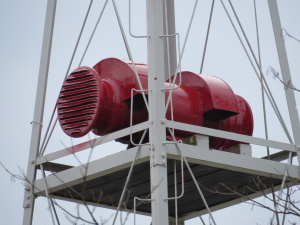Sterling Model M: Difference between revisions
mNo edit summary |
No edit summary |
||
| (3 intermediate revisions by one other user not shown) | |||
| Line 2: | Line 2: | ||
{{Infobox siren | {{Infobox siren | ||
|image= | |image= | ||
[[File:IMG_8094.JPG|thumb|Sterling M | [[File:IMG_8094.JPG|thumb|Sterling Model M in Mantua, Ohio.]] | ||
|company=[[Sterling | |company=[[Sterling Siren Fire-Alarm Company, Inc.]] | ||
|type=[[Electromechanical]] | |type=[[Electromechanical]] | ||
|produced= | |produced= 1912-1973 | ||
}} | }} | ||
The M | The Model M is a horizontally oriented, electric siren manufactured by The Sterling Siren Fire Alarm Company, of Rochester, New York. These sirens were primarily marketed for fire alarm and general alarm use, intended to serve as a more distinct and efficient alternative to fire bells and steam whistles. The Model M is believed to have started its production in 1912, and was quickly and widely successful, so much so that it is believed almost every volunteer fire department in the New England area had one at some point. | ||
Model Ms were offered in a single and double head configurations, Single and dual tone configurations were also offered, with the Sterling Model M being among the first double toned sirens manufactured. | |||
The M | The Model M was designed in the early 1900s by Merton C. Armstrong, superintendent and lead designer of the Sterling Siren Fire Alarm Company, with the goal of creating a new and distinct fire alarm signal to replace antiquated methods such as the use of Air/Steam Whistles and Bells. The Model M does this by employing the same principles used on Sterling Siren's smaller vehicular models, but at a substantially larger scale. | ||
[[Category:Sirens]] | [[Category:Sirens]] | ||
Latest revision as of 18:09, 1 December 2023
| Sterling Model M | |
 | |
| Company | Sterling Siren Fire-Alarm Company, Inc. |
|---|---|
| Produced | 1912-1973 |
| Type | Electromechanical |
The Model M is a horizontally oriented, electric siren manufactured by The Sterling Siren Fire Alarm Company, of Rochester, New York. These sirens were primarily marketed for fire alarm and general alarm use, intended to serve as a more distinct and efficient alternative to fire bells and steam whistles. The Model M is believed to have started its production in 1912, and was quickly and widely successful, so much so that it is believed almost every volunteer fire department in the New England area had one at some point.
Model Ms were offered in a single and double head configurations, Single and dual tone configurations were also offered, with the Sterling Model M being among the first double toned sirens manufactured.
The Model M was designed in the early 1900s by Merton C. Armstrong, superintendent and lead designer of the Sterling Siren Fire Alarm Company, with the goal of creating a new and distinct fire alarm signal to replace antiquated methods such as the use of Air/Steam Whistles and Bells. The Model M does this by employing the same principles used on Sterling Siren's smaller vehicular models, but at a substantially larger scale.